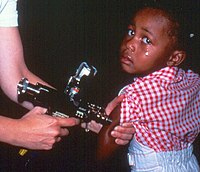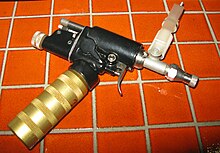| Revision as of 12:34, 6 May 2011 editTristanb (talk | contribs)Extended confirmed users4,614 editsm →Concerns: who is re:vaccination← Previous edit | Revision as of 12:52, 6 May 2011 edit undoTristanb (talk | contribs)Extended confirmed users4,614 edits →Concerns: prev inj abscessesNext edit → | ||
| Line 65: | Line 65: | ||
| }}</ref> | }}</ref> | ||
| As well as transmission between patients, jet injectors have inoculated bacteria from the environment into users. In 1988 a podiatry clinic used a jet injector to deliver ] into patients' toes. Eight of these patients developed infections caused by '']''. The injector was stored in a container of water and disinfectant between use, and the container grew the same organism.<ref name=" |
As well as transmission between patients, jet injectors have inoculated bacteria from the environment into users. In 1988 a podiatry clinic used a jet injector to deliver ] into patients' toes. Eight of these patients developed infections caused by '']''. The injector was stored in a container of water and disinfectant between use, and the container grew the same organism.<ref name="mycobact_inj1">{{Cite journal | ||
| | doi = 10.1001/jama.1990.03450030097040 | | doi = 10.1001/jama.1990.03450030097040 | ||
| | volume = 264 | | volume = 264 | ||
| Line 78: | Line 78: | ||
| | date = 1990-07-18 | | date = 1990-07-18 | ||
| | url = http://jama.ama-assn.org/content/264/3/373.abstract | | url = http://jama.ama-assn.org/content/264/3/373.abstract | ||
| }}</ref> This species of bacteria is sometimes found in tap water, and had been previously associated with infections from jet injectors.<ref name="inman">{{Cite journal | |||
| | issn = 0003-987X | |||
| | volume = 100 | |||
| | issue = 2 | |||
| | pages = 141-147 | |||
| | last = Inman | |||
| | first = P M | |||
| | coauthors = A Beck, A E Brown, J L Stanford | |||
| | title = Outbreak of injection abscesses due to Mycobacterium abscessus | |||
| | journal = Archives of Dermatology | |||
| | accessdate = 2011-05-06 | |||
| | date = 1969-08 | |||
| | url = http://www.ncbi.nlm.nih.gov/pubmed/5797954 | |||
| }}</ref> | }}</ref> | ||
Revision as of 12:52, 6 May 2011
| This article has multiple issues. Please help improve it or discuss these issues on the talk page. (Learn how and when to remove these messages)
No issues specified. Please specify issues, or remove this template. (Learn how and when to remove this message) |

A jet injector is a type of medical injecting syringe that uses a high-pressure narrow jet of the injection liquid instead of a hypodermic needle to penetrate the epidermis. They are powered by compressed air or gas, either by a pressure hose from a large cylinder, or from a built-in gas cartridge or small cylinder.
They are used for mass vaccination, or as an alternative to needle syringes for diabetics to inject insulin. As well as health uses, similar devices are used in other industries to inject grease or other fluid.
Types of jet injector

The Jet Injector Gun and the Ped-O-Jet are air-powered medical injector devices designed to administer vaccinations in an extremely efficient manner. Invented by Aaron Ismach, these medical devices were bought in mass quantities by the US Government and provided to governments around the world to eradicate smallpox and other diseases. Servicemen in the Armed Forces were routinely injected with these medical devices to immunize them, and civilian usage included vaccinations during flu epidemics and the like. The Jet Injector is powered by electricity, while the Ped-O-Jet version is powered by a foot pump and does not require electricity to administer the vaccines. These devices have various specialized nozzles for different medication densities and also permitted the efficient inoculation of animal populations as well.
The Biojector 2000 is a make of gas-cartridge-powered jet injector. It is claimed that it can deliver intramuscular injections and subcutaneous injections up to 1 milliliter. The part which touches the patient's skin is single-use and can be replaced easily. It can be powered from a big compressed gas cylinder instead of gas cartridges. It is made by Bioject.
Concerns
Despite wide use by the military and in large-scale vaccination campaigns, there have been few reported incidents of transmission of disease between users. Because the jet injector breaks barrier of the skin, there is a potential that biological material is transferred from one user to the next. Some viruses such as hepatitis B require less than one millionth of a millilitre to be transmitted so makers of injectors need to ensure there is no cross-contamination between applications. Regarding vaccination, the World Health Organization states that jet injectors "are no longer recommended due to risks of disease transmission".
An experiment using mice, published in 1985, showed that jets injectors would frequently transfer the viral infection LDV from one mouse to another. Another study used the device on a calf, then tested the fluid remaining in the injector for blood. Every injector they tested had detectable blood in a quantity sufficient to pass on a virus such as hepatitis B.
From 1984-1985 a weight-loss clinic in Brazil injected a pregnancy hormone into their clients, mostly using a jet injector. It was noted that a number of these patients became sick with hepatitis. When studied, 57 out of 239 people who received the jet injection tested positive for hepatitis B.
As well as transmission between patients, jet injectors have inoculated bacteria from the environment into users. In 1988 a podiatry clinic used a jet injector to deliver local anaesthetic into patients' toes. Eight of these patients developed infections caused by Mycobacterium chelonae. The injector was stored in a container of water and disinfectant between use, and the container grew the same organism. This species of bacteria is sometimes found in tap water, and had been previously associated with infections from jet injectors.
History
- 19th century: Workmen in France had accidental jet injections with high-powered grease guns
- 1920s: Diesel engines begin to be made in large quantities: thus beginning of serious risk of accidental jet-injection by their fuel injectors as workshop accidents.
- 1937: First known recorded accidental jet injection by a diesel engine's fuel injector.
- 1960: Aaron Ismach invented and patented the Jet Injector medical device which was used for quick mass vaccination for smallpox and other diseases. Ismach was assisted by Dr. Abram Benenson in developing the Jet Injector Gun. The new method met with tremendous success as teams vaccinated large numbers of people at collecting points in the affected countries. The foot operated gun was called the Ped-O-Jet and the electric operated gun was called the Jet Injector Gun.
- 1962: Robert Andrew Hingson claimed to have invented a prototype jet injector and called it the peace gun, for quick mass vaccination. But sometimes the injection process dislodged infected matter from a patient onto the nozzle of the injector, risking cross-infection.
- 1964: Aaron Ismach was presented with a Gold Medal from the US Government for his efforts related to the Jet Injector Gun. The Jet Injector also appeared on postage stamps as a commemorative of his efforts.
- September 1966: The Star Trek series started, exposing the public to the idea of jet injectors under the name "hypospray".
- 1976: The USA Agency for International Development published a book called War on Hunger which detailed the War Against Smallpox which Ismach's Jet Injector gun was used to eradicate the disease in Africa and Asia. The US Government spent $150 million a year to prevent its recurrence in North America.
- 1997: The USA Department of Defense, the jet injector's biggest user, announced that it would stop using it for mass vaccinations due to concerns about infection. The DoD order Veterans info page
Popular culture
In the Star Trek franchise, and sometimes in other fictional scenarios and occasionally in the real world, it is called a hypospray.
Accidental jet injection
Accidents have happened in vehicle repair garages and elsewhere where one of these has unintentionally acted as a hypodermic jet injector:
- A fuel injector of a diesel engine.
- A high-pressure grease gun.
- A pinhole leak in a tube supplying a high-powered grease gun from a separate grease pressure-tank.
- A pinhole leak in a tube of high pressure hydraulic oil equipment.
- A high pressure paint spray.
- A pressure washer.
High pressure injections of oil or paint can cause very serious injuries which may require amputation and can induce fatal blood poisoning. Particular care must be taken around high pressure sprays of this kind to avoid such injuries.
References
- ^
Hoffman, P.N (2001-07-16). "A model to assess the infection potential of jet injectors used in mass immunisation". Vaccine. 19 (28–29): 4020–4027. doi:10.1016/S0264-410X(01)00106-2. ISSN 0264-410X. Retrieved 2011-05-06.
{{cite journal}}: Unknown parameter|coauthors=ignored (|author=suggested) (help) - World Health Organization (2005-07-13). "Solutions: Choosing Technologies for Safe Injections". Retrieved 2011-05-06.
- BRINK, P. R. G. (1985-12-01). "Virus Transmission by Subcutaneous Jet Injection". J Med Microbiol. 20 (3): 393–397. doi:<p>10.1099/00222615-20-3-393</p>. Retrieved 2011-05-06.
{{cite journal}}: Check|doi=value (help); Unknown parameter|coauthors=ignored (|author=suggested) (help) - Canter, Jeffrey (1990-09-01). "An Outbreak of Hepatitis B Associated With Jet Injections in a Weight Reduction Clinic". Arch Intern Med. 150 (9): 1923–1927. doi:<p>10.1001/archinte.1990.00390200105020</p>. Retrieved 2011-05-06.
{{cite journal}}: Check|doi=value (help); Unknown parameter|coauthors=ignored (|author=suggested) (help) - Wenger, Jay D. (1990-07-18). "Outbreak of Mycobacterium chelonae Infection Associated With Use of Jet Injectors". JAMA: The Journal of the American Medical Association. 264 (3): 373–376. doi:10.1001/jama.1990.03450030097040. Retrieved 2011-05-06.
{{cite journal}}: Unknown parameter|coauthors=ignored (|author=suggested) (help) - Inman, P M (1969-08). "Outbreak of injection abscesses due to Mycobacterium abscessus". Archives of Dermatology. 100 (2): 141–147. ISSN 0003-987X. Retrieved 2011-05-06.
{{cite journal}}: Check date values in:|date=(help); Unknown parameter|coauthors=ignored (|author=suggested) (help) - Rees CE. "Penetration of tissue by fuel oil under high pressure from diesel engine." JAMA 1937;109:866-7
External links
| This article's use of external links may not follow Misplaced Pages's policies or guidelines. Please improve this article by removing excessive or inappropriate external links, and converting useful links where appropriate into footnote references. (January 2010) (Learn how and when to remove this message) |
- Problems in use of jet injectors by diabetics
- Memory Alpha (Star Trek Wiki) page about the hypospray
Web pages using "hypospray" for a real jet injector
These three references are all to articles in scientific periodicals:-
- Comparison of two steroid preparations used to treat tennis elbow, using the hypospray (1975)
- The use of the hypospray in the treatment of minor orthopaedic conditions (1969)
- Use of the hypospray jet injector for intra-articular injection (1967)
- This link uses the name "hypospray" for an automatic tourniquet.
External links about accidental jet injection
- http://bmj.bmjjournals.com/cgi/content/full/312/7044/1436 (registration required)
- http://www.napavalleypetroleum.com/msds_napa_no2_diesel_fuel.htm (scroll down to section 7)
| Routes of administration, dosage forms | |||||||||||||||||||||||
|---|---|---|---|---|---|---|---|---|---|---|---|---|---|---|---|---|---|---|---|---|---|---|---|
| Oral |
| ||||||||||||||||||||||
| Ophthalmic, otic, nasal | |||||||||||||||||||||||
| Urogenital |
| ||||||||||||||||||||||
| Rectal (enteral) | |||||||||||||||||||||||
| Dermal (topical) | |||||||||||||||||||||||
(into tissue/blood) |
| ||||||||||||||||||||||





